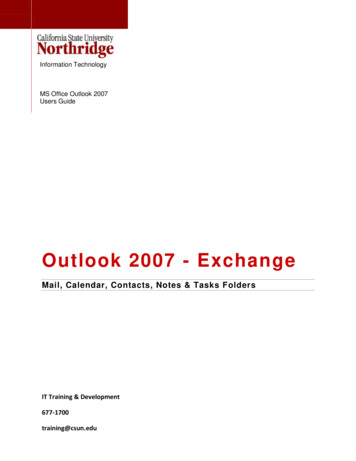Transcription
2022 semiconductorindustry outlook
2022 semiconductor industry outlook2022 semiconductor industry outlookSemiconductors have now established their placeas a truly essential industry. There are multiple“essential” industries, of course: We can’t dowithout food, energy, logistics, and so on. Butit took the chip shortages of 2020 and 2021 forsemiconductors to cement their “critical” status.ContentsThe chip shortage continues, as production will take time to catch up to demand4The hunt for silicon talent intensifies5The move to localize chip manufacturing gains momentum6Digital transformation efforts accelerate7Signposts for the future8In 2022, the global semiconductor chip industry is expected toreach about US 600 billion.1 But while it’s still dwarfed by farming,oil and gas—industries that are worth an annual US 10 trillion andUS 5 trillion in revenue, respectively—80% of the world’s food orfuel doesn’t come from a handful of manufacturers concentratedin a just a few countries.Semi companies have also been making strides in their effortsat greater diversity, equity, inclusion, and sustainability. They arebecoming more diverse and inclusive (specifically narrowing thegender gap5) and are committing to reducing their environmentalfootprint. Interestingly, the sector’s biggest challenge may be waterusage,6 although improving their energy use is also a focus area.7Across multiple end markets, the absence of a single critical chip,often costing less than a dollar, can prevent the sale of a deviceworth tens of thousands of dollars. Based on our analysis, the chipshortage of the past two years resulted in revenue misses of morethan US 500 billion worldwide between the semiconductor and itscustomer industries, with lost auto sales of more than US 210 billionin 2021 alone.2Over the long run, semiconductor revenues are likely to oscillatearound a trend line. Still, that trend line looks steeper than everbefore as we enter a period of robust secular growth.Although annual semiconductor sales have traditionally trendedupward, they have also demonstrated a characteristic cyclicality,with periods of growth and contraction. In contrast, the growthin chip criticality has been a steady one that may even accelerate.Two factors are driving this trend. First, more and more productshave at least some chips integrated into their design every year,and more and more products have more chips than they used to,from connected devices in our homes to smart tags on every boxin a warehouse. That’s not all; chips are also rising in their valueand capabilities. For example, the semi content per car will roughlydouble between 2013 and 2030.3Although shortages have been painful for some customers, the chipindustry itself is thriving. The Philadelphia Semiconductor Index(SOX) is up 117% in the past two years,4 while the Nasdaq has onlybeen up 90%. Revenues, earnings, and cash flow are strong for chipcompanies, allowing for ongoing investment in new plants, newbusiness models, and accelerated digital transformation.About outlooksDeloitte’s 2022 semiconductor industry outlook seeks to identify the strategic issues and opportunities for semiconductor companies to consider inthe coming year, including their impacts, key actions to take, and critical questions to ask. The goal is to equip US semiconductor (aka semi or chip)companies with the information and foresight they need to position themselves for a robust and resilient future.2 We expect the global industry to grow 10% in 2022 to overUS 600 billion for the first time ever. Growth will likely be downfrom 25% growth in 2021, in line with the Semiconductor IndustryAssociation and World Semiconductor Trade Statistics.8 Chips willbe even more important across all industries, driven by increasingsemiconductor content in everything from cars to appliances tofactories, in addition to the usual suspects—computers, datacenters, and phones. We expect shortages and supply chain issues to remain front andcenter for the first half of the year, hopefully easing by the backhalf, but with longer lead times for some components stretchinginto 2023, possibly well into 2023. The ongoing talent shortage will be made even more severe bythe addition of increased semiconductor manufacturing facilitiesoutside Taiwan, China, and South Korea. The higher demandfor software skills required to program and integrate chips intofast-growing markets such as electric vehicles, robotics, homeautomation, artificial intelligence, and 5G, as well as part of theshift from fossil fuels to green energy, will further exacerbate theshortage, and there is also an overall labor shortage. Finally, we expect the digital transformation within the industry tocontinue and accelerate. Nearly three out of five chip companieshave already begun their transformation journey. Still, over half ofthose are modifying their transformation process as they go, inresponse to various pressures.93
2022 semiconductor industry outlook2022 semiconductor industry outlookThe chip shortage continues,as production will take time tocatch up to demandThe top semiconductor issue of 2021 was the imbalance betweensupply and demand. This imbalance led to chip shortages thataffected both traditional chip end markets, such as data centers andsmartphones, and traditionally less dependent markets, such asautomotive, consumer white goods, and—rather infamously—dogwashing machines.10If you guessed that supply and demand will also be a top issue of2022, you’re likely to be right. However, next year will not be anidentical repeat of 2021. In contrast, we expect the severity andduration of the chip shortage, and its economic ramifications, tobe less pronounced because of increased capacity, but also fromsupply chain improvements that chipmakers, distributors, and endcustomers make.Adding new capacity began in 2021 but won’t be operational until2023 at the earliest. Luckily, some new capacity additions werealready in the pipeline before the shortage—we expect to see 200mm wafer capacity rise by more than 10% for the year, while 300mm will be up by 15%.In terms of process technology, our analysis (based on Gartner data) suggests the most advanced nodes (10 nm and under) willgrow 24% year over year in 2022; intermediate nodes (14 nm to45 nm) will grow 14%; and mature nodes (65 nm and above) willgrow by 9%.11 Although much attention has been paid to moreadvanced nodes, it’s worth noting that even in 2022, mature nodemanufacturing is expected to account for nearly 64% of global chipoutput, measured in wafer equivalents.12More capacity is a good thing; however, other, less obvious supplychain improvements may positively impact excessive lead timesjust as much. These fall into two interdependent trends: movingto a digital capabilities model and collaborating on a digital supplynetwork. And while neither trend started amid the pandemic and itsrelated shortages, both were accelerated because of it.To find their footing in 2022, semi companies should move to adigital capabilities model, and should redesign their traditionalorganizational silos to create a more connected and integratedmodel—one that encompasses their customers, talent, suppliersacross all tiers, channel partners, and internal facilities. They shouldalso work to adopt better customer connections, synchronizedplanning, dynamic fulfillment, supplier collaboration, operationscommand centers, and digital development.4Meanwhile, semiconductor producers, distributors, and customersshould work together to transform their legacy supply chain intoa digital supply network, by sensing, collaborating, optimizing,and responding with greater agility. As an example of effectivecollaboration, companies can work closely with ecosystem partners(both upstream and downstream) to facilitate real-time informationsharing and understanding, in addition to greater capturing andaddressing of the potential impact to sensed signals. As an exampleof better data sharing from 2021, one prominent Silicon Valleycompany that shared its chip needs with manufacturers for the next12 months moved to five-year forecasts instead.13The hunt for silicontalent intensifiesA widespread post-pandemic worker shortage prevails, propelled inpart by the “Great Resignation,” in which more than 4 million Americanworkers quit their jobs in August 2021 alone.14The semiconductor industry is also feeling the pinch, albeitexponentially worse. In addition to sharing the factors affecting otherindustries, the chip business has four megatrends that are making thewar for talent even more severe:1. G lobal semi industry revenues by the end of 2022 will be almost50% higher than at the end of 2019.152. T here were already talent shortages in Taiwan and South Korea in2017. The talent pool in those areas was relatively well developed,but recent growth has nearly exhausted it.16Strategic questions to consider: How can C-level executives balance their actionsand investments that they are making towardalleviating or expediting shortages in the shortterm versus longer-term fixes to capacity andsupply chain? How can a better view of true aggregateddemand forecast be developed realistically(e.g., by filtering out double/triple-counting,over optimism), while gaining insight into thereal supply capacity investment needed? How can the changing nature of demandfrom core devices to edge/IoT/5G-enableddevices be addressed? This shift to the edge ischanging the ecosystems, products, and routesto market that semiconductor companies haveto operate in, and there are big operating model,partnership/channel, and product strategydecisions they should make. How can a better end-to-end, multi-enterpriseview of the supply chain be built by consideringvital aspects related to data sharing, privacy,security, and confidentiality?3. Over time, building more local chip fabrication plants (aka fabs) inthe United States, China, Singapore, Israel, and other countries willallow chip companies to access a broader, deeper pool of talent.In the short term, although there are millions of talented workersin those areas, they must be trained to acquire essential skills—anecessary step that will not be resolved in 2022.The chip industry can help address its talent shortage by moreproactively engaging with universities to advance STEM skills ofgraduates and bolster innovation. Both efforts are critical tohelping the United States sustain its long-term global semiconductorleadership and competitiveness.21 Another step chip companiescan take to address the talent gap is to directly tap into internationalalliances and ecosystems.22To cater to the growing hybrid work model, semi companiesneed innovative ways to help enable collaboration between coremanufacturing, technical, and R&D staff. Several companies alreadyseem to be on this path: 42% identified corporate culture/environmentand collaboration as crucial for their business transformation.23Major chip manufacturers also enhanced their work/life balanceinitiatives, employee assistance, and well-being programs to bettersupport their organizations during the pandemic. 2022 will likely requirethem to be even more agile with their workforce development andemployee benefit programs, both of which will prove crucial to theirability to retain and grow talent.4. The mix of job skills is changing, and the industry has a strong needfor software skills. Our analysis of multiple industry estimatessuggests that global electronic design automation (EDA) softwarerevenue is anticipated to double from approximately 10 billion in2020 to 19 billion by 2027. The need for software hires is likely tofollow a similar trend.Strategic questions to consider:On a global level, the most severe talent shortage this year is likely tobe in China. There were about 510,000 professionals in semiconductordesign and manufacturing in the country as of 2019. A 2021 reportsuggested a talent shortfall that year of about 300,000 workers, anumber projected to fall only slightly to 250,000 by 2022.17 As companies adopt alternative talent strategiesto cater to a distributed workforce, what local- andstate-level tax policies should be considered, andwhat specific roles should be permanent or full-timeversus contract-based?There are about 280,000 American professionals in semiconductordesign and manufacturing.18 New plants in Arizona and Texas will likelycreate close to 5,000 high-tech manufacturing and engineering jobs,and other proposed new plants could more than doublethat number.19Even as domestic chip companies are experiencing engineering andmanufacturing talent shortages, they are also facing competition fortalent from other tech majors aggressively expanding in high-growthareas, including artificial intelligence (AI), edge computing, robotics, 5G,and smart devices.20 These technologies demand similar types of skills,intensifying the ongoing battle for semiconductor talent. How can companies develop and train their talentpool in a hybrid work model by leveraging a banquetof options such as on-the-job training, self-pacedlearning, and onsite/offsite mentorship? What specific tasks can be automated or robotizedwithin each job role? How can companies enhancethe human-machine connection, such as usingaugmented reality (AR), virtual reality (VR),mixed reality (MR), or AI for more effectiveteaming and productivity?5
2022 semiconductor industry outlook2022 semiconductor industry outlookThe move to localize chipmanufacturing gains momentumDigital transformationefforts accelerateThe global semiconductor industry is committing to increasingtheir overall output capacity at an unprecedented level. Capitalexpenditures from the three largest players will likely exceed 200billion from 2021 to 2023.24 Governments have committed hundredsof billions of dollars more.25 We expect global wafer starts to be fully50% higher by the end of 2023 than they were in 2020. Some willoccur in traditional manufacturing clusters located in Taiwan andSouth Korea; but increasingly, they will be in the United States,China, Japan, Singapore, Israel, and Europe—a trend known as“localization”26—increasing chip production closer to the next stepin the supply chain.If semiconductor companies are to strengthen their competitiveedge, they should be the first to launch new products, rapidly scaleproduction, and focus on innovation and efficiency. These factors—coupled with the advent of new technology end markets, customers’shift to design chips in-house, global trade wars, and the supplychain disruption during the pandemic—have forced them to reinventtheir business and operating models. In line with these externalmarket drivers, the Deloitte Semiconductor Transformation Study(STS) found that nearly three out of five chip companies had alreadyembarked on some form of digital transformation by mid-2021.31There are multiple drivers for localization; although, it is worthnoting that it reverses a multi-decade trend to a well-developedand fine-tuned global supply chain. From chip design andwafer manufacturing, to packaging, testing, original equipmentmanufacturer (OEM) assembly, and more, there are dozens ofcountries involved.Moving global supply chain capabilities into a single countryor region will not be easy, but when making the argument forlocalization, here are some things to consider:1. A s the pandemic has demonstrated, having “all yoursemiconductor eggs in one basket” leaves multiple industriesvulnerable to the hazards from having manufacturer andconsumer thousands of miles apart: blocked canals, jammedports, and so on. Over 60% of all chips were made in East Asiain 2020.272. M oving manufacturing closer to end users is now seen as aprudent national strategy to reduce risk.3. H eightened tensions in the East Asia manufacturing region havedrawn attention to a global vulnerability of profound supplydisruption due to blockades or military action.284. O ngoing trade restrictions and embargoes suggest a need forgreater local autonomy of manufacturing, especially in China.295. C hipmaking is increasingly seen as a driver for the overall digitaleconomy. In addition to providing local jobs, having a minimumcritical mass of semi manufacturing capacity within borders isa key part of national or regional industrial policy in 2022 andbeyond, an issue seemingly pressing in Europe at present.306As is customary in industrial policy conversations, chipmakers aremore than happy to build new plants in new locales as long as theincentives (usually tax-related) are large enough. Hundreds of billionsof dollars will likely be needed going forward.Moreover, one of the reasons the industry has been so highlyconcentrated geographically was that there were multiple economiesof scale at work that rewarded concentrations. As chip companiesmove toward localization, they should consider inherent risks andother possible pitfalls.Strategic questions to consider: As companies pursue localization, what changesshould they make in the near and long termwith regards to manufacturing and supply-sidecapacity footprint? While companies intend to localize chipproduction, what potential sources ofinvestments can they tap into—includingnational, local, and strategic partners? How might access to talent markets, support fortechnical services, energy and water availability,and tax structure and policies change and affectthe long-term expansion strategy and road map?Nonetheless, the survey revealed that half of semiconductorcompanies had yet to modify their transformation strategy to adaptto the dynamic marketplace changes that took place during 2021.For two-thirds of those surveyed, their transformation strategy didnot fully align with their organization and culture. Moreover, nearlyone in ten had no defined transformation strategy whatsoever.Little surprise almost half of chip companies experienced materialchanges to their digital transformation plans while they werein progress.In 2022, chip industry executives should address the fallouts of acomplex and unpredictable market environment that has affectedtheir business functions and supply chains. They should establisha clear end-state vision, versus being hasty when planning andformulating a transformation strategy. As digital business modeltransformations require changing operating models and adoptingnew digital and talent capabilities, chip companies should take anintegrated approach—considering various entities both withinand outside the enterprise—to be more resilient to futurebusiness disruptions.32Semi companies should also bolster their collaboration withextended supply network partners so that they can betterimplement integrated AI, edge computing, 5G communications,and Internet of Things (IoT) solutions. Their transformationshould represent the end markets they are expanding into andthe capabilities that will best enable their growth and expansion.Deploying these technologies internally can help unleash capabilities,such as greater visibility of data across the corporate and supplynetwork, timely and real-time intelligence, and automating keyprocesses. All can be essential to executing their transformationinitiatives. Enhancing customer experience is also a critical elementas chip companies strive to acquire new customers in new markets.The STS noted that starting in 2022, half of chip companies mightplan to offer everything-as-a-service (XaaS) based solutions,representing a shift from the traditional one-time product salesmodel. As companies ponder this path, they should also considerhow new offerings could change the way they go to market, whatproduct engineering and design changes would be required, andhow revenue models need to change.33Strategic questions to consider: Does the transformation strategyconsider all the various entities includingtechnology, workforce, businessfunctions including strategic businessunits, channel and distribution partners,and end-market customers? As part of the transformation roadmap, what business partnerships,alliances, and novel talent and designcapabilities do companies need toconsider or develop? How do companies need to changetheir business and operating modelsto monetize more of the valuetheir IP, chips, and solutionsprovide (e.g., silicon asa service)?7
2022 semiconductor industry outlook2022 semiconductor industry outlookSignposts for the futureIn 2022, the semiconductor industry will experiencecontinued strong growth, even as it takes steps toaddress chip shortages, manage lead times with suppliersand end customers, build manufacturing capacity locallyor nearshore, hire specialized engineering and designtalent, and bolster its supply networks using advanceddigital solutions.For fab equipment makers, integrated device manufacturers, fabless chip design companies,foundries, and chip distribution partners alike, the trends and developments will affect andinfluence their strategies and business moves.ContactsJohn CiacchellaPrincipalDeloitte Consulting LLP 1 408 704 4659jciacchella@deloitte.comBrandon KulikPrincipalDeloitte Consulting LLP 1 714 436 7530bkulik@deloitte.comDan HamlingSpecialist MasterTechnology IndustriesDeloitte Consulting LLP 1 619 674 9384dhamling@deloitte.comChris RichardSemiconductor IndustryPrincipalDeloitte Consulting LLP 1 602 234 5194chrisrichard@deloitte.comFor 2022 and beyond, we recommendsemiconductor industry executives bemindful of the following signposts: Lead times for chips: 12 weeks is about average, somoving toward that level is a key goal before the endof the year.34 Inventory levels for end customers and distributors:As a result of the shortage, some customers may behoarding or at least over-ordering. Once the shortageresolves, they could start working down excessinventories, leading to abruptly decreased demand. Money and pressure from governments: There iscurrently strong financial and political support forlocalization at both the national and regional levelsof government, but semi companies should be onthe alert for flagging support, as well as canceled orabandoned incentives.8 Wage inflation: The ongoing talent war continues to seecompanies struggle to fill positions. Compensation hasnot risen materially; however, as the competition fortalent intensifies, that could change. Capital expenditure levels: Current run rates areover 100 billion annually, and as the industry shiftsinto balance, stakeholders may start arguing fora reduction. Unforeseeable global and regional disruptions: Significantglobal/regional political, trade, or conflict events orenvironmental issues (typhoons, earthquakes, droughts)could cause supply chain shocks and disruption andyet again radically alter chip companies’ strategies andbusiness models.9
2022 semiconductor industry outlookEndnotes1.World Semiconductor Trade Statistics (WSTS), “WSTS semiconductor market forecast fall 2021,” press release, November 30, 2021.2.Michael Wayland, “Chip shortage expected to cost auto industry 210 billion in revenue in 2021,” CNBC, September 23, 2021.3.Deloitte, Semiconductors – the next wave: Opportunities and winning strategies for semiconductor companies, April 2019.4.Analysis of market indices as of November 4, 2021, compared to same date in 2019.5.Susanne Hupfer et al., “Women in the tech industry: Gaining ground, but facing new headwinds,” Deloitte Global TMT Predictions 2022, December 1, 2021.6.S&P Global, “ESG Industry Report Card: Technology,” May 21, 2019.7.Udit Gupta et al., “Chasing carbon: The elusive environmental footprint of computing,” Proceeding—27th IIIE International Symposium on High Performance ComputerArchitecture, HPCA 2021 (pp. 854–67).8.WSTS press release.9.Brandon Kulik et al., 2021 Semiconductor Transformation Study: Top executive insights on transformations affecting the semiconductor ecosystem, a Deloitte study incollaboration with Global Semiconductor Alliance (GSA), October 2021.10. Jeanne Whalen, “How the global chip shortage might affect people who just want to wash their dogs,” Washington Post, May 2, 2021.11. Calculation performed by Deloitte, based on data from 2021 Gartner Forecast: Semiconductor Foundry Revenue, Supply and Demand, Worldwide, 3Q21 Update,September 2021.12. Ibid.13. Don Clark, “Chip shortage creates new power players,” New York Times, November 8, 2021.14. Sharron Epperson and Michelle Fox, “The ‘Great Resignation’ is burning out those who stay. Here’s what they can do,” CNBC, November 2, 2021.15. WSTS press release. Global industry revenues were US 412.3 billion in 2019 and are predicted to be US 601.5 billion in 2022, or up 46%.16. Elliot Silverberg and Eleanor Hughes, “Semiconductors: The skills shortage,” Lowy Institute, September 15, 2021.17. Dashveenjit Kaur, “China is fighting a chronic talent shortage in the semiconductor industry,” Techwire Asia, October 25, 2021.18. Semiconductor Industry Association (SIA), 2021: State of the U.S. semiconductor industry, 2021.19. Based on Deloitte’s analysis of publicly available information sources.20. Moreover, engineers used the pandemic-driven disruption to reinvent their skills and specialize in new fields. Read further: Joe McKendrick, “Artificial intelligence andautomation’s paradox: More human talent needed to reduce need for human talent,” Forbes, May 19, 2021.21. As part of the United States Innovation and Competition Act (USICA) of 2021, the government has committed to 5.22 billion worth of STEM student scholarships(between 2022 and 2026), besides funding STEM workforce programs and bolstering university technology centers and innovation institutes. Read further: Silverbergand Hughes, “Semiconductors: The skills shortage,” Lowy Institute.22. Initiatives such as the MicroElectronics Training Industry and Skills (METIS) and the SEMI Foundation’s Global Workforce Development Initiative have establishedmulti-entity models to attract, train, and retain qualified engineers.23. Brandon Kulik et al., 2021 Semiconductor Transformation Study.24. Deloitte analysis of public announcements from selected large public companies that make semiconductors.25. Deloitte analysis of publicly announced United States, European Union, and Chinese initiatives.26. Geektime, “Taiwan & Israel’s joint future within the semiconductor industry,” August 18, 2021.27. Alex Irwin-Hunt, “In charts: Asia’s manufacturing dominance,” Financial Times, March 23, 2021.28. Alan Crawford et al., “The world is dangerously dependent on Taiwan for semiconductors,” Bloomberg, January 25, 2021.29. Cissy Zhou, “US-China tech war: Can China’s chipmaking drive save it from US technology embargo?,” South China Morning Post, September 28, 2020.30. Pat Gelsinger, “Computer chip manufacturing is an investment in Europe’s technology leadership,” Politico, September 3, 2021.31. Brandon Kulik et al., 2021 Semiconductor Transformation Study.32. Rich Nanda et al., “A new language for digital transformation,” Deloitte, September 23, 2021.33. The Deloitte’s STS noted that nearly half of respondents plan to introduce usage, subscription, or outcome-based revenue models. Even “hardware” companies,including those producing chips and equipment, are forging paths toward nontraditional models.34. Joel Hruska, “Semiconductor shortage enters ‘danger zone’ as lead times rise,” ExtremeTech, May 20, 2021.GARTNER is a registered trademark and service mark of Gartner, Inc. and/or its affiliatesin the US and internationally and is used herein with permission. All rights reserved.10
This publication contains general information and predictions only and Deloitteis not, by means of this publication, rendering accounting, business, financial,investment, legal, tax, or other professional advice or services. This publication isnot a substitute for such professional advice or services, nor should it be used asa basis for any decision or action that may affect your business. Before making anydecision or taking any action that may affect your business, you should consulta qualified professional adviser. Deloitte shall not be responsible for any losssustained by any person who relies on this publication.About DeloitteDeloitte refers to one or more of Deloitte Touche Tohmatsu Limited, a UK privatecompany limited by guarantee (“DTTL”), its network of member firms, and their related entities. DTTL and each of its member firms are legally separate and independent entities. DTTL (also referred to as “Deloitte Global”) does not provide servicesto clients. In the United States, Deloitte refers to one or more of the US memberfirms of DTTL, their related entities that operate using the “Deloitte” name in theUnited States and their respective affiliates. Certain services may not be availableto attest clients under the rules and regulations of public accounting. Please seewww.deloitte.com/about to learn more about our global network of member firms.Copyright 2022 Deloitte Development LLC. All rights reserved.
2022 semiconductor industry outlook 2022 semiconductor industry outlook The top semiconductor issue of 2021 was the imbalance between supply and demand. This imbalance led to chip shortages that affected both traditional chip end markets, such as data centers and smartphones, and traditionally less dependent markets, such as








